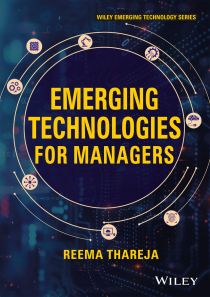Emerging Technologies for Managers
ISBN: 9789363863354
624 pages
For more information write to us at: acadmktg@wiley.com

Description
Step into the forefront of innovation with Emerging Technology for Managers, a comprehensive guide designed for aspiring managers. This book offers an in-depth exploration of the most transformative technologies today, including AI, Virtual Reality, Data Science, Blockchain, IoT, Cloud Computing, Digital Manufacturing, Robotics, and 3D Printing. It not only simplifies these complex fields but also highlights their real-world applications across various industries. Discover how to leverage the opportunities these technologies bring and address the challenges they pose. As we enter a new digital era, this book provides essential insights into the profound impacts on society, the economy, and the environment. Equip yourself with the knowledge to shape the future and take your first step toward technological mastery.
About The Book
About The Author
Acknowledgment
Chapter 1 Artificial Intelligence (AI)
1.1 Introduction
1.2 Introduction to Artificial Intelligence [AI]
1.2.1 Broad Spectrum of AI
1.2.2 The Significance of AI: Why Learn AI?
1.2.3 What Is AI?
1.2.4 History of AI
1.2.5 Types of AI
1.2.6 Levels of AI
1.2.7 AI Tools and Platforms
1.3 Applications of AI
1.3.1 Industry-Specific AI Applications
1.3.2 Agriculture
1.3.3 Business
1.3.4 Health
1.3.5 Education
Summary
Keywords
Objective Questions
Descriptive Questions
Suggested Readings
e-References
Chapter 2 Internet of Things (IoT)
2.1 Introduction
2.2 Overview of IoT
2.2.1 History of IoT
2.2.2 Evolution of IoT
2.2.3 IoT Standards and Frameworks
2.2.4 Sensors
2.3 Understanding IoT: Functionality and Use Cases
2.3.1 Components of IoT
2.3.2 Architecture of IoT
2.3.3 IoT Devices
2.3.4 IoT Networks
2.3.5 Applications of IoT
2.3.6 IoT Based Smart Farming
Summary
Keywords
Objective Questions
Descriptive Questions
Suggested Readings
e-References
Chapter 3 Cloud Computing
3.1 Introduction
3.2 What is Cloud Computing?
3.2.1 Cloud Computing: Overview
3.2.2 Cloud Computing: Nature and Benefits
3.2.3 Cloud Service Models
3.2.4 Other Cloud Services
3.2.5 Virtualisation and Containerization
3.2.6 Cloud Security
3.3 Cloud Platforms
3.3.1 Types of Cloud Platforms
3.3.2 AWS
3.3.3 Google Cloud Platform (GCP)
3.3.4 Microsoft Azure
3.3.5 Vendor Offering – IBM
Summary
Keywords
Objective Questions
Descriptive Questions
Suggested Readings
Chapter 4 Blockchain
4.1 Introduction to Blockchain
4.1.1 Blockchain Transparency
4.1.2 Need of Blockchain
4.1.3 Is Blockchain Secure?
4.1.4 Fundamentals of Blockchain
4.1.5 Principles and Technologies
4.1.6 Cryptocurrencies
4.1.7 Bitcoin
4.1.8 Public Ledgers
4.1.9 Smart Contracts
4.1.10 Blockchain Applications and Use Cases
4.2 Understanding Blockchain and Other Aspects
4.2.1 Benefits of Blockchains
4.2.2 Drawbacks of Blockchains
4.2.3 Block in a Block Chain
4.2.4 Blockchain Transactions
4.2.5 Distributed Consensus
4.2.6 Permissioned Model of Block chain
4.2.7 Overview of Security Aspects of Blockchain
Summary
Keywords
Objective Questions
Descriptive Questions
e-References
Chapter 5 Digital Manufacturing
5.1 Introduction
5.2 The History and Survey of 3D Printing
5.2.1 What Is 3D Printing?
5.2.2 Common 3D Printing Methods
5.2.3 Design Principles
5.2.4 Emerging Trends in 3D Printing
5.2.5 Limitations of 3D Printing
5.2.6 Introduction of Drones, Engineering Disciplines
5.2.7 Multirotor Drone Assembly Course/Regulations and
Procedures for Becoming a Drone Pilot
Summary
Keywords
Objective Questions
Descriptive Questions
e-References
Chapter 6 Robotics
6.1 Introduction
6.1.1 Key Components of a Robot
6.1.2 Classification of Robots
6.1.3 Control Systems
6.1.4 Kinematics Systems
6.1.5 Robot Manipulators
6.1.6 Social Issues and Safety
6.2 Robot Anatomy and Motion Analysis
6.2.1 Anatomy of a Robot
6.2.2 Robot Configurations
6.2.3 Types of Robotic Movements
6.2.4 Degrees of Freedom
Summary
Keywords
Objective Questions
Descriptive Questions
Suggested Readings
e-References
Chapter 7 Data Science
7.1 Introduction to Data Science
7.2 Overview of Data Science
7.2.1 Introduction to Data Science
7.2.2 Types of Data
7.2.3 Introduction to Data Science Mindset
7.2.4 Data Science Process
7.2.5 Data Science Toolkit
7.3 Fundamentals of Data Science
7.3.1 Data Analysis
7.3.2 Data Structures
7.3.3 Data Visualisation
7.3.4 Data Mining
7.3.5 Applications of Data Science
Summary
Keywords
Objective Questions
Descriptive Questions
Suggested Readings
Chapter 8 Cyber Security
8.1 Overview of Cybersecurity
8.1.1 Introduction to Cyber Security
8.1.2 Layers of Security
8.1.3 Challenges and Constraints
8.1.4 Computer Crimes and Criminals
8.1.5 CIA Triad
8.1.6 Cyber Assets
8.1.7 Cyber Threats
8.2 Cryptography and Cryptanalysis
8.2.1 Introduction to Cryptography
8.2.2 Symmetric Key Cryptography
8.2.3 Asymmetric Key Cryptography
8.2.4 Hash Functions
8.2.5 Cryptanalysis
8.2.6 Digital Signatures
8.2.7 Overview of Firewalls
Summary
Keywords
Objective Questions
Descriptive Questions
Suggested Readings
e-References 410
Chapter 9 3D Printing and Design
9.1 3D Printing (Additive Manufacturing)
9.1.1 Introduction
9.1.2 Process
9.1.3 Classification
9.1.4 Advantages
9.1.5 Additive vs. Conventional Manufacturing Processes
9.1.6 Real-Life Applications
9.2 Cad for Additive Manufacturing
9.2.1 CAD Data Formats
9.2.2 Data translation
9.2.3 Data Loss
9.2.4 STL Format
Summary
Keywords
Objective Questions
Suggested Readings
e-References
Chapter 10 Ethics and Professionalism of Emerging Technologies
10.1 Introduction
10.1.1 Ethical Concerns in Emerging Technologies
10.1.2 Technology and Ethics
10.1.3 General Ethical Principles
10.1.4 Professional Responsibilities
10.2 Privacy in Technologies
10.2.1 Privacy Threats from Today’s Computer Systems
10.2.2 Data Privacy
10.2.3 Data Privacy Laws and GDPR
10.2.4 Digital Privacy
10.2.5 Emerging Ethical Dilemmas in Science and Technology
10.2.6 Ethical Dimensions and Dilemmas in
Emerging Technologies
10.2.7 Communication Privacy
10.2.8 Ethical and Regulatory Challenges
10.2.9 Emerging Technologies Shaping Privacy
10.2.10 Encryption and Decryption
Summary
Keywords
Objective Questions
Descriptive Questions
Suggested Readings
e-References
Chapter 11 Virtual Reality
11.1 Introduction to Virtual Reality
11.1.1 Types of Virtual Reality
11.1.2 Virtual Reality and Virtual Environment
11.1.3 Computer Graphics
11.1.4 Real-Time Computer Graphics
11.1.5 Flight Simulation
11.1.6 Virtual Environment Requirements
11.1.7 Benefits of Virtual Reality
11.1.8 Real-Life Application
Summary
Keywords
Objective Questions
Descriptive Questions
Suggested Readings
e-References
Chapter 12 Future Trends
12.1 Emerging Future Trends And Other Emerging Technologies
12.1.1 Augmented Reality (AR) and Virtual Reality (VR)
12.1.2 5G Telecom
12.1.3 5G in India, Application and Use Cases
12.1.4 Brain Computer Interface, Application, Model and Global Market
12.1.5 Brain-Computer Interface and Human Brain
12.2 Other Emerging Technologies
12.2.1 Quantum Computing
12.2.2 Nanotechnology
12.2.3 3D Printing
12.2.4 Autonomic Computing
12.2.5 Embedded Systems
Summary
Keywords
Objective Questions
Descriptive Questions
Suggested Readings
e-References
Index

